
Code Visual to FlowChart 5.x serial key or number

Code Visual to FlowChart 5.x serial key or number
Visustin v8 Flow chart generator
Home
Products Visustin
Visustin  Add language
Add language Online Help
Online Help Samples
Samples Service
Service User comments
User comments What's new
What's new Why flow charts
Why flow charts
Download
Order
Articles
Help
Site map
Visualize your source code with flow charts and UML Activity Diagrams. Visustin is flowcharting software that converts your source code to flow charts—automatically! Draw flow charts with your mouse. View and print charts or export to Visio.
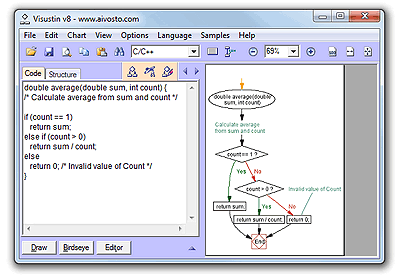 | Convert source code $249 / $499 Understand and Download demo |
| Visustin flowcharts 49 languages | ||
|---|---|---|
|
|
|
| Orange languages are new in Visustin v8 | ||
| More languages available | ||
Need flow charts for another language? MPASM, R, Progress anyone? Add new language | ||
Visustin for software developers. Visustin is an automated flow chart program for software developers and document writers. Save documentation efforts with automatic code visualization. Visustin reverse engineers your source code to flow charts or UML Activity Diagrams. Visustin reads the and statements, loops and jumps and builds a diagram—fully automated.
No manual drawing is required. Visustin flowcharts ABAP, ActionScript, Ada, ASP, several assembly languages, AutoIt, BASIC, .bat files, C, C++, C#, Clipper, COBOL, ColdFusion, Delphi, Fortran, GW-BASIC, HTML, Java, JavaScript, JCL (MVS), JavaServer Pages, LotusScript, MATLAB, MXML, Pascal, Perl, PHP, PL/I, PL/SQL, PowerBASIC, PowerBuilder PowerScript, PureBasic, Python, QuickBASIC, REALbasic, Rexx, RPG, Ruby, SAS, Tcl, TSQL, Unix shell script (bash, csh, tcsh, ksh, sh), VB, VBA, VBScript, VB.Net, Visual FoxPro, XHTML, XML and XSLT.
Visustin for document writers. Add flow charts to your project documentation. Clear diagrams instantly tell the reader what even the most complex code does. Save your efforts with automated documentation!
| Review algorithms | → Fix bugs |
| Follow complex logic | → Avoid bugs |
| Compare functions | → Find errors |
| Restructure bad code | → Add quality |
| Document programs | → Save effort |
| Read strange languages | → Reuse code |
Visustin for code review. Verify program logic with flow charts. Find bugs before the users do. Save costs by fixing bugs earlier than before.
Visustin for debuggers. Can't see the bug? View a flow graph to gain new insight and speed up debugging.
Visustin for software maintenance. Flowchart old functions to understand them before modifications. After writing changes, flowchart the new version to verify the algorithm. Improved quality guarantees happy users.
Convert languages. Converting old code to a new language? Avoid conversion errors. Flowchart both versions to detect any differences. Extract business rules from legacy code. Flowchart routines to document the rules embedded in them. Read an unfamiliar language. Visualize program logic even if the code is in a language you don't know well. Restructure old spaghetti code. Confirm the results with flow charts. Understand the incomprehensible. View convoluted code in a new light. Gained insight helps you fix old bugs and avoid adding new ones. |
Features
Flowchart code automatically. Visustin converts source code to flow charts automatically. An automated layout ensures visually optimal results. Just hit a key and you're done. The charts visualize your code and optionally the comments as well.
Edit flow charts. Visustin Editor lets you edit the automatically created charts. Insert comments, add shapes, highlight important points, adjust links, fine-tune the layout. [Pro Edition]
Draw flow charts manually. Visustin Editor lets you draw flow charts from scratch with the mouse. Document your business processes. Plan your systems before building them. [Pro Edition]
UML. Prefer UML style? No problem! Visustin supports both flow charts and UML Activity Diagrams.
Multi-page print. Print large flow charts as a multi-page mosaic. Squeeze to fit on one sheet.
PDF flow charts. Save high-quality PDF charts. They are great to zoom and pan.
Save charts. Use flow graphs in your project documentation. Save files in BMP, GIF, JPEG, PNG, TIFF, MHT, EMF or WMF format. Create web pages showing both the code and the flow chart.
Export to Visio. Save your drawing efforts. Convert your source code to Microsoft Visio diagrams. More about Visio export[Pro Edition]
Export to Word. Add flow charts to technical documents.
Bulk charting. Flowchart all your source files in one run. Create Visio diagrams unattended. Run flowchart jobs in a batch. Add automated flowcharting as a part of your application's build process. Keep your technical documents updated every night. [Pro Edition]
Download for free
Download demo
Download and try Visustin now. Free flowcharting trial software that diagrams all your code. No size limitation.
Print, Save and Export are disabled in the free demo. No problem! Use our free flowcharting service. We will save or export for you. Just send us some code. We can even send a PDF to print.
System requirements. Windows 2000/XP/2003/Vista/7/8/10.
Mac? Run Visustin on the Mac the same way you run other Windows programs.
More information
Online Help
Order Visustin
Sample flow charts
Why flow charts
Add language
Flowcharting service
User comments
What's new in Visustin
Choose between 2 editions: Standard and Pro
| Edition | Standard | Pro |
|---|---|---|
| Create charts from code | Yes | Yes |
| Yes | Yes | |
| Save | Yes | Yes |
| Draw charts with Editor | - | Yes |
| Export to Visio | - | Yes |
| Bulk flowchart | - | Yes |
Prices and licensing details
| Visustin license | 1 user | 2-pack | 3-pack | Team (5) | 10-pack | +1 user | Site |
|---|---|---|---|---|---|---|---|
| Standard Edition | $249 | $419 | $589 | $749 | $1149 | +$80 | |
| Pro Edition | $499 | $839 | $1190 | $1490 | $2290 | +$160 | $5990 |
| Standard Educational | $149 | ||||||
| +1 user: Additional users beyond 3, 5 or 10. Discounted upgrade prices for existing users. | |||||||
Try it for free.Download Visustin, a high-quality automated flowcharter. It makes sense of source code however bad and complex. Visustin is risk-free and comes with a full 30-day money back guarantee.
2 installations per license. A single user license covers one user and two computers. For 2 users one needs a 2-pack, for 3 users a 3-pack and so on. A site license allows 100 installations. Other license sizes are available on request. Reinstallation is allowed if previous installations are removed first. Online activation is required before running the full software. Offline activation is possible through another, online computer. Activation is covered for 3 years after purchase. License and activation details
Upgrades. Minor updates are free within one major version number (8.xx → 8.yy). No free updates are guaranteed to come out. Major upgrades are discounted, see What's new in Visustin v8.
See also: A different kind of diagramming tool for Visual Basic
Project Analyzer is a great companion for Visustin, if you're working with Visual Basic. Project Analyzer produces high-level VB graphs such as call trees and dependency diagrams. Visustin flowcharts the details. Navigate your code with Project Analyzer, flowchart it with Visustin.
Flowchart maker for abap, as, asm, asp, au3, bas, bat, c, cbl, cfm, cmd, cls, cob, cpp, cs, f, f77, f90, f95, frm, java, jcl, js, html, lss, m, mxml, pas, php, pl, pl1, pli, prg, py, rex, sas, sh, tcl, vb, vbs, xml, xsl and other files. Flow chart software to reverse engineer code, view flow diagrams, create Visio flow charts and debug algorithms. Built-in features: flowchart viewer, flow graph printer.
©Aivosto Oy
C programming Tutorial
Getting Started - Write your First Hello-world C Program
Let's begin by writing our first C program that prints the message "Hello, world!" on the display console:
Hello, world!Step 1: Write the Source Code: Enter the following source codes using a programming text editor (such as NotePad++ for Windows or gEdit for UNIX/Linux/Mac) or an Interactive Development Environment (IDE) (such as CodeBlocks, Eclipse, NetBeans or MS Visual Studio - Read the respective "How-To" article on how to install and get started with these IDEs).
Do not enter the line numbers (on the left panel), which were added to help in the explanation. Save the source file as "". A C source file should be saved with a file extension of "". You should choose a filename which reflects the purpose of the program.
| 1 2 3 4 5 6 7 8 9 | /* * First C program that says Hello (Hello.c) */ #include <stdio.h> // Needed to perform IO operations int main() { // Program entry point printf("Hello, world!\n"); // Says Hello return 0; // Terminate main() } // End of main() |
Step 2: Build the Executable Code: Compile and Link (aka Build) the source code "" into executable code ("" in Windows or "" in UNIX/Linux/Mac).
- On IDE (such as CodeBlocks), push the "Build" button.
- On Text editor with the GNU GCC compiler, start a CMD Shell (Windows) or Terminal (Mac, Linux) and issue these commands: // Windows (CMD shell) - Build "Hello.c" into "Hello.exe" > gcc -o Hello.exe Hello.c // UNIX/Linux/Mac (Bash shell) - Build "Hello.c" into "Hello" $ gcc -o Hello Hello.c where is the name of GCC C compiler; option specifies the output filename ("" for Windows or "" for UNIX/Linux/Mac); "" is the input source file.
Step 3: Run the Executable Code: Execute (Run) the program.
- On IDE (such as CodeBlocks), push the "Run" button.
- On Text Editor with GNU GCC compiler, issue these command from CMD Shell (Windows) or Terminal (UNIX/Linux/Mac): // Windows (CMD shell) - Run "Hello.exe" (.exe is optional) > Hello Hello, world! // UNIX/Linux/Mac (Bash shell) - Run "Hello" (./ denotes the current directory) $ ./Hello Hello, world!
Brief Explanation of the Program
/* ...... */
// ... until the end of the line
These are called comments. Comments are NOT executable and are ignored by the compiler. But they provide useful explanation and documentation to your readers (and to yourself three days later). There are two kinds of comments:
- Multi-line Comment: begins with and ends with . It may span more than one lines (as in Lines 1-3).
- End-of-line Comment: begins with and lasts until the end of the current line (as in Lines 4, 6, 7, 8, and 9).
#include <stdio.h>
The "" is called a preprocessor directive. A preprocessor directive begins with a sign, and is processed before compilation. The directive "" tells the preprocessor to include the "" header file to support input/output operations. This line shall be present in all our programs. I will explain its meaning later.
int main() { ...... }
defines the so-called function. The function is the entry point of program execution. is required to return an (integer).
printf("Hello, world!\n");
We invoke the function to print the string "Hello, world!" followed by a newline () to the console. The newline () brings the cursor to the beginning of the next line.
return 0;
terminates the function and returns a value of 0 to the operating system. Typically, return value of 0 signals normal termination; whereas value of non-zero (usually 1) signals abnormal termination. This line is optional. C compiler will implicitly insert a "" to the end of the function.
C Terminology and Syntax
Statement: A programming statement performs a piece of programming action. It must be terminated by a semi-colon () (just like an English sentence is ended with a period) as in Lines 7 and 8.
Preprocessor Directive: The (Line 4) is a preprocessor directive and NOT a programming statement. A preprocessor directive begins with hash sign (). It is processed before compiling the program. A preprocessor directive is NOT terminated by a semicolon - Take note of this rule.
Block: A block is a group of programming statements enclosed by braces . This group of statements is treated as one single unit. There is one block in this program, which contains the body of the function. There is no need to put a semi-colon after the closing brace.
Comments: A multi-line comment begins with and ends with . An end-of-line comment begins with and lasts till the end of the line. Comments are NOT executable statements and are ignored by the compiler. But they provide useful explanation and documentation. Use comments liberally.
Whitespaces: Blank, tab, and newline are collectively called whitespaces. Extra whitespaces are ignored, i.e., only one whitespace is needed to separate the tokens. But they could help you and your readers better understand your program. Use extra whitespaces liberally.
Case Sensitivity: C is case sensitive - a ROSE is NOT a Rose, and is NOT a rose.
The Process of Writing a C Program
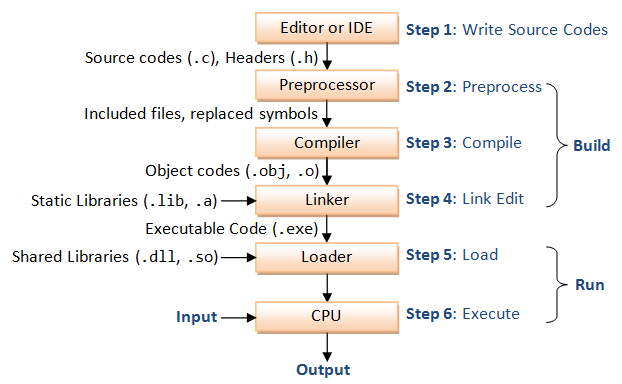
Step 1: Write the source codes () and header files ().
Step 2: Pre-process the source codes according to the preprocessor directives. The preprocessor directives begin with a hash sign (), such as and . They indicate that certain manipulations (such as including another file or replacement of symbols) are to be performed BEFORE compilation.
Step 3: Compile the pre-processed source codes into object codes (, ).
Step 4: Link the compiled object codes with other object codes and the library object codes (, )to produce the executable code ().
Step 5: Load the executable code into computer memory.
Step 6: Run the executable code.
C Program Template
You can use the following template to write your C programs. Choose a meaningful filename for you source file that reflects the purpose of your program with file extension of "". Write your programming statements inside the body of the function. Don't worry about the other terms for the time being. I will explain them later.
| 1 2 3 4 5 6 7 8 9 10 | /* * Comment to state the purpose of this program (filename.c) */ #include <stdio.h> int main() { // Your Programming statements HERE! return 0; } |
Let's Write a Program to Add a Few Numbers
Example: Adding Two Integers
Let's write a C program called "" to add two integers as follows:
Add2Integers.c
| 1 2 3 4 5 6 7 8 9 10 11 12 13 14 15 16 17 18 19 | /* * Add two integers and print their sum (Add2Integers.c) */ #include <stdio.h> int main() { int integer1; // Declare a variable named integer1 of the type integer int integer2; // Declare a variable named integer2 of the type integer int sum; // Declare a variable named sum of the type integer integer1 = 55; // Assign value to variable integer1 integer2 = 66; // Assign value to variable integer1 sum = integer1 + integer2; // Compute the sum // Print the result printf("The sum of %d and %d is %d.\n", integer1, integer2, sum); return 0; } |
Dissecting the Program
int integer1;
int integer2;
int sum;
We first declare three (integer) variables: , , and . A variable is a named storage location that can store a value of a particular data type, in this case, (integer). You can declare one variable in one statement. You could also declare many variables in one statement, separating with commas, e.g.,
integer1 = 55;
integer2 = 66;
sum = integer1 + integer2;
We assign values to variables and ; compute their sum and store in variable .
printf("The sum of %d and %d is %d.\n", integer1, integer2, sum);
We use the function to print the result. The first argument in is known as the formatting string, which consists of normal texts and so-called conversion specifiers. Normal texts will be printed as they are. A conversion specifier begins with a percent sign (), followed by a code to indicate the data type, such as for decimal integer. You can treat the as placeholders, which will be replaced by the value of variables given after the formatting string in sequential order. That is, the first will be replaced by the value of , second by , and third by . The denotes a newline character. Printing a bring the cursor to the beginning of the next line.
Example: Prompting User for Inputs
In the previous example, we assigned fixed values into variables and . Instead of using fixed values, we shall prompt the user to enter two integers.
PromptAdd2Integers.c
| 1 2 3 4 5 6 7 8 9 10 11 12 13 14 15 16 17 18 19 20 | /* * Prompt user for two integers and print their sum (PromptAdd2Integers.c) */ #include <stdio.h> int main() { int integer1, integer2, sum; // Declare 3 integer variablesprintf("Enter first integer: "); // Display a prompting messagescanf("%d", &integer1); // Read input from keyboard into integer1printf("Enter second integer: "); // Display a prompting messagescanf("%d", &integer2); // Read input into integer2 sum = integer1 + integer2; // Compute the sum // Print the result printf("The sum of %d and %d is %d.\n", integer1, integer2, sum); return 0; } |
Disecting the Program
int integer1, integer2, sum;
We first declare three (integer) variables: , , and in one statement.
printf("Enter first integer: ");
We use the function to put out a prompting message.
scanf("%d", &integer1);
We then use the function to read the user input from the keyboard and store the value into variable .The first argument of is the formatting string (similar to ).The conversion specifier provides a placeholder for an integer, which will be substituted by variable . Take note that we have to place an ampersand sign (), which stands for address-of operator, before the variable, I shall explain its significance later. It is important to stress that missing ampersand () in is a common error, which leads to abnormal termination of the program.
Reading Multiple Integers
You can read multiple items in one statement as follows:
printf("Enter two integers: "); // Display a prompting message scanf("%d%d", &integer1, &integer2); // Read two integersIn the , the first puts the first integer entered into variable , and the second puts into . Again, remember to place an ampersand () before the variables in .
Exercises
- Print each of the following patterns. Use one statement for each line of outputs. End each line by printing a newline (). * * * * * * * * * * * * * * * * * * * * * * * * * * * * * * * * * * * * * * * * * * * * * * * * * * * * * (a) (b) (c)
- Print the above patterns using ONE statement.
- Write a program to prompt user for 5 integers and print their sum. Use five variables to to store the five integers.
- Write a program to prompt user for 5 integers and print their product. Use an variable to store the product and operator for multiplication.
What is a Program?
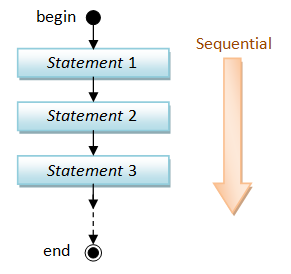
A program is a sequence of instructions (called programming statements), executing one after another - usually in a sequential manner, as illustrated in the previous example and the following flow chart.
Example (Sequential): The following program () prompts user for the radius of a circle, and prints its area and circumference. Take note that the programming statements are executed sequentially - one after another in the order that they are written.
| 1 2 3 4 5 6 7 8 9 10 11 12 13 14 15 16 17 18 19 20 21 22 23 24 | /* * Prompt user for the radius of a circle and compute its area and circumference * (CircleComputation.c) */ #include <stdio.h> int main() { double radius, circumference, area; // Declare 3 floating-point variables double pi = 3.14159265; // Declare and define PI printf("Enter the radius: "); // Prompting message scanf("%lf", &radius); // Read input into variable radius // Compute area and circumference area = radius * radius * pi; circumference = 2.0 * radius * pi; // Print the results printf("The radius is %lf.\n", radius); printf("The area is %lf.\n", area); printf("The circumference is %lf.\n", circumference); return 0; } |
Dissecting the Program
double radius, circumference, area;
double pi = 3.14159265;
We declare three variables called , and . A variable, unlike , can hold real number (or floating-point number) such as 1.23 or 4.5e6. We also declare a variable called and initialize its value to 3.1416.
printf("Enter the radius: ");
scanf("%lf", &radius);
We use to put up a prompt message, and to read the user input into variable . Take note that the conversion specifier for ( stands for long float). Also remember to place an ampersand () before .
area = radius * radius * pi;
circumference = 2.0 * radius * pi;
perform the computation.
printf("The radius is %lf.\n", radius);
printf("The area is %lf.\n", area);
printf("The circumference is %lf.\n", circumference);
Again, we use conversion specifier to print a .
Take note that the programming statements inside the are executed one after another, sequentially.
Exercises
- Follow the above example, write a program to print the area and perimeter of a rectangle. Your program shall prompt the user for the length and width of the rectangle, in s.
- Follow the above example, write a program to print the surface area and volume of a cylinder. Your program shall prompt the user for the radius and height of the cylinder, in s.
What is a Variable?
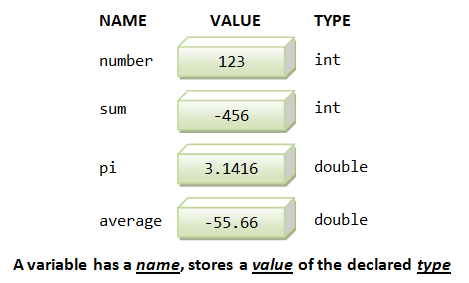
Computer programs manipulate (or process) data. A variable is used to store a piece of data for processing. It is called variable because you can change the value stored.
More precisely, a variable is a named storage location, that stores a value of a particular data type. In other words, a variable has a name, a type and stores a value of that type.
- A variable has a name (or identifier), e.g., , , , . The name is needed to uniquely identify and reference a variable, so as to assign a value to the variable (e.g., ), and retrieve the value stored (e.g., ).
- A variable has a type. Examples of type are:
- : for integers (whole numbers) such as and ;
- : for floating-point or real numbers, such as , , , , having a decimal point and fractional part, in fixed or scientific notations.
- A variable can store a value of the declared type. It is important to take note that a variable is associated with a type, and can only store value of that particular type. For example, a variable can store an integer value such as , but NOT real number such as , nor texts such as . The concept of type was introduced into the early programming languages to simplify interpretation of data.
The above diagram illustrates 2 types of variables: and . An variable stores an integer (whole number). A variable stores a real number.
To use a variable, you need to first declare its name and type, in one of the following syntaxes:
var-typevar-name; // Declare a variable of a typevar-typevar-name-1, var-name-2,...; // Declare multiple variables of the same typevar-typevar-name = initial-value; // Declare a variable of a type, and assign an initial valuevar-typevar-name-1 = initial-value-1, var-name-2 = initial-value-2,... ; // Declare variables with initial valuesTake note that:
- Each declaration statement is terminated with a semi-colon ().
- In multiple-variable declaration, the names are separated by commas ().
- The symbol , known as the assignment operator, can be used to assign an initial value (of the declared type) to the variable.
For example,
int sum; // Declare a variable named "sum" of the type "int" for storing an integer. // Terminate the statement with a semi-colon. int number1, number2; // Declare two "int" variables named "number1" and "number2", // separated by a comma. double average; // Declare a variable named "average" of the type "double" for storing a real number. int height = 20; // Declare an int variable, and assign an initial value.Once a variable is declared, you can assign and re-assign a value to a variable, via the assignment operator "". For example,
int number; // Declare a variable named "number" of the type "int" (integer) number = 99; // Assign an integer value of 99 to the variable "number" number = 88; // Re-assign a value of 88 to "number" number = number + 1; // Evaluate "number + 1", and assign the result back to "number" int sum = 0; // Declare an int variable named sum and assign an initial value of 0 sum = sum + number; // Evaluate "sum + number", and assign the result back to "sum", i.e. add number into sum int num1 = 5, num2 = 6; // Declare and initialize two int variables in one statement, separated by a comma double radius = 1.5; // Declare a variable name radius, and initialize to 1.5int number;// ERROR: A variable named "number" has already been declaredsum = 55.66;// WARNING: The variable "sum" is an int. It shall not be assigned a floating-point numbersum = "Hello";// ERROR: The variable "sum" is an int. It cannot be assigned a text stringTake note that:
- Each variable can only be declared once.
- You can declare a variable anywhere inside the program, as long as it is declared before it is being used.
- Once the type of a variable is declared, it can only store a value belonging to this particular type. For example, an variable can hold only integer such as , and NOT floating-point number such as or text string such as .
- The type of a variable cannot be changed inside the program.
x=x+1?
Assignment () in programming is different from equality in Mathematics. e.g., "" is invalid in Mathematics. However, in programming, it means compute the value of plus 1, and assign the result back to variable .
"x+y=1" is valid in Mathematics, but is invalid in programming. In programming, the RHS of "" has to be evaluated to a value; while the LHS shall be a variable. That is, evaluate the RHS first, then assign to LHS.
Some languages uses as the assignment operator to avoid confusion with equality.
Basic Arithmetic Operations
The basic arithmetic operators are:
| Operator | Meaning | Example |
|---|---|---|
| Addition | ||
| Subtraction | ||
| Multiplication | ||
| Division | ||
| Modulus (Remainder) | ||
| Increment by 1 (Unary) | or | |
| Decrement by 1 (Unary) | or |
Addition, subtraction, multiplication, division and remainder are binary operators that take two operands (e.g., ); while negation (e.g., ), increment and decrement (e.g., , ) are unary operators that take only one operand.
Example
The following program () illustrates these arithmetic operations.
| 1 2 3 4 5 6 7 8 9 10 11 12 13 14 15 16 17 18 19 20 21 22 23 24 25 26 27 28 29 30 31 32 33 34 35 36 37 | /* * Test arithmetic operations (TestArithmetics.c) */ #include <stdio.h> int main() { int number1, number2; // Declare 2 integer variable number1 and number2 int sum, difference, product, quotient, remainder; // declare 5 int variables // Prompt user for the two numbers printf("Enter two integers (separated by space): "); scanf("%d%d", &number1, &number2); // Use 2 %d to read 2 integers // Do arithmetic Operations sum = number1 + number2; difference = number1 - number2; product = number1 * number2; quotient = number1 / number2; remainder = number1 % number2; printf("The sum, difference, product, quotient and remainder of %d and %d are %d, %d, %d, %d, %d.\n", number1, number2, sum, difference, product, quotient, remainder); // Increment and Decrement ++number1; // Increment the value stored in variable number1 by 1 // same as "number1 = number1 + 1" --number2; // Decrement the value stored in variable number2 by 1 // same as "number2 = number2 - 1" printf("number1 after increment is %d.\n", number1); printf("number2 after decrement is %d.\n", number2); quotient = number1 / number2; printf("The new quotient of %d and %d is %d.\n", number1, number2, quotient); return 0; } |
Dissecting the Program
int number1, number2;
int sum, difference, product, quotient, remainder;
declare all the (integer) variables , , , , , , and , needed in this program.
printf("Enter two integers (separated by space): ");
scanf("%d%d", &number1, &number2);
prompt user for two integers and store into and , respectively.
sum = number1 + number2;
difference = number1 - number2;
product = number1 * number2;
quotient = number1 / number2;
remainder = number1 % number2;
carry out the arithmetic operations on and . Take note that division of two integers produces a truncated integer, e.g., , , and .
printf("The sum, difference, product, quotient and remainder of %d and %d are %d, %d, %d, %d, %d.\n",
number1, number2, sum, difference, product, quotient, remainder);
prints the results of the arithmetic operations, with the appropriate string descriptions in between.
++number1;
--number2;
illustrate the increment and decrement operations. Unlike , , , and , which work on two operands (binary operators), and operate on only one operand (unary operators). is equivalent to , i.e., increment x by 1. You may place the increment operator before or after the operand, i.e., (pre-increment) or (post-increment). In this example, the effects of pre-increment and post-increment are the same. I shall point out the differences in later section.
Exercises
- Introduce one more variable called , and prompt user for its value. Print the sum and product of all the three integers.
- In Mathematics, we could omit the multiplication sign in an arithmetic expression, e.g., . In programming, you need to explicitly provide all the operators, i.e., . Try printing the sum of times of and times of and time of .
What If Your Need To Add a Thousand Numbers? Use a Loop!
Suppose that you want to add all the integers from 1 to 1000. If you follow the previous examples, you would require a thousand-line program! Instead, you could use a loop in your program to perform a repetitive task, that is what the dumb computers are good at.
Example
Try the following program , which sums all the integers from 1 to an upperbound provided by the user, using a so-called while-loop.
| 1 2 3 4 5 6 7 8 9 10 11 12 13 14 15 16 17 18 19 20 21 22 23 24 25 | /* * Sum from 1 to an upperbound using a while-loop (SumNumbers.c). */ #include <stdio.h> int main() { int sum = 0; // Declare an int variable sum to accumulate the numbers // Set the initial sum to 0 int upperbound; // Sum from 1 to this upperbound // Prompt user for an upperbound printf("Enter the upperbound: "); scanf("%d", &upperbound); // Use %d to read an int // Use a loop to repeatedly add 1, 2, 3,..., up to upperbound int number = 1; while (number <= upperbound) { sum = sum + number; // accumulate number into sum ++number; // increment number by 1 } // Print the result printf("The sum from 1 to %d is %d.\n", upperbound, sum); return 0; } |
Dissecting the Program
int sum = 0;
declares an variable named and initializes it to 0. This variable will be used to accumulate numbers over the steps in the repetitive loop.
printf("Enter the upperbound: ");
scanf("%d", &upperbound);
prompt user for an upperbound to sum.
int number = 1;
while (number <= upperbound) {
sum = sum + number;
++number;
}
This is the so-called while-loop. A while-loop takes the following syntax:
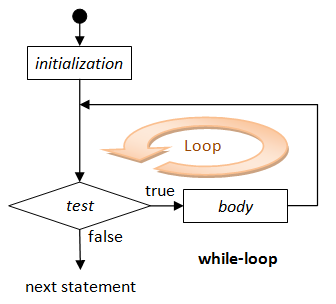 initialization-statement; while (test) {loop-body;}next-statement;
initialization-statement; while (test) {loop-body;}next-statement;As illustrated in the flow chart, the initialization statement is first executed. The test is then checked. If the test is true, the body is executed. The test is checked again and the process repeats until the test is false. When the test is false, the loop completes and program execution continues to the next statement after the loop.
In our program, the initialization statement declares an variable named and initializes it to 1. The test checks if is equal to or less than the . If it is true, the current value of is added into the , and the statement increases the value of by 1. The test is then checked again and the process repeats until the test is false (i.e., increases to ), which causes the loop to terminate. Execution then continues to the next statement (in Line 22).
In this example, the loop repeats times. After the loop is completed, Line 22 prints the result with a proper description.
Exercises
- Modify the above program to sum all the number between a lowerbound and an upperbound provided by the user.
- Modify the above program to sum all the odd numbers between to an upperbound. (Hint: Use "".)
- Modify the above program to sum all the numbers between to an upperbound that are divisible by . (Hint: Use "")
- Modify the above program to find the sum of the square of all the numbers from to an upperbound, i.e.
- Modify the above program to compute the product of all the numbers from to . (Hint: Use a variable called instead of and initialize to 1. Ans: .) Based on this code, write a program to display the factorial of n, where n is an integer between to .
Conditional (or Decision)
What if you want to sum all the odd numbers and also all the even numbers between 1 and 1000? There are many way to do this. You could declare two variables: and . You can then use a conditional statement to check whether the number is odd or even, and accumulate the number into the respective sum. The program is as follows:
| 1 2 3 4 5 6 7 8 9 10 11 12 13 14 15 16 17 18 19 20 21 22 23 24 25 26 27 28 29 30 31 32 | /* * Sum the odd and even numbers from 1 to an upperbound (SumOddEven.c) */ #include <stdio.h> int main() { int sumOdd = 0; // For accumulating odd numbers, init to 0 int sumEven = 0; // For accumulating even numbers, init to 0 int upperbound; // Sum from 1 to this upperbound // Prompt user for an upperbound printf("Enter the upperbound: "); scanf("%d", &upperbound); // Use %d to read an int // Use a loop to repeatedly add 1, 2, 3,..., up to upperbound int number = 1; while (number <= upperbound) { if (number % 2 == 0) { // even number sumEven = sumEven + number; } else { // odd number sumOdd = sumOdd + number; } ++number; // increment number by 1 } // Print the results printf("The sum of odd numbers is %d.\n", sumOdd); printf("The sum of even numbers is %d.\n", sumEven); printf("The difference is %d.\n", (sumOdd - sumEven)); return 0; } |
Dissecting the Program
int sumOdd = 0;
int sumEven = 0;
declare two variables named and and initialize them to 0, for accumulating the odd and even numbers, respectively.
if (number % 2 == 0) {
sumEven = sumEven + number;
} else {
sumOdd = sumOdd + number;
}
This is a conditional statement. The conditional statement can take one these forms: if-then or if-then-else.
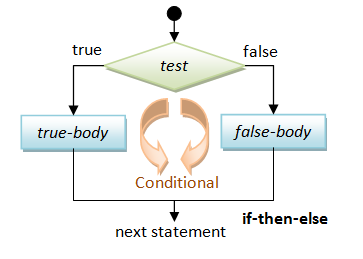
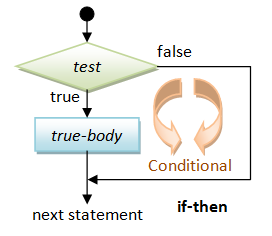 // if-thenif (test) {true-body;}// if-then-elseif (test) {true-body;} else {false-body;}
// if-thenif (test) {true-body;}// if-then-elseif (test) {true-body;} else {false-body;}For a if-then statement, the true-body is executed if the test is true. Otherwise, nothing is done and the execution continues to the next statement. For a if-then-else statement, the true-body is executed if the test is true; otherwise, the false-body is executed. Execution is then continued to the next statement.
In our program, we use the remainder operator to compute the remainder of divides by . We then compare the remainder with to test for even number.
Comparison Operators
There are six comparison (or relational) operators:
| Operator | Meaning | Example |
|---|---|---|
| Equal to | ||
| Not equal to | ||
| Greater than | ||
| Greater than or equal to | ||
| Less than | ||
| Less than or equal to |
Take note that the comparison operator for equality is a double-equal sign ; whereas a single-equal sign is the assignment operator.
Combining Simple Conditions
Suppose that you want to check whether a number is between and (inclusive), i.e., . There are two simple conditions here, . In programming, you cannot write , but need to write , where "" denotes the "" operator. Similarly, suppose that you want to check whether a number is divisible by 2 OR by 3, you have to write where "" denotes the "" operator.
There are three so-called logical operators that operate on the boolean conditions:
| Operator | Meaning | Example |
|---|---|---|
| Logical AND | ||
| Logical OR | ||
| Logical NOT |
For examples:
// Return true if x is between 0 and 100 (inclusive) (x >= 0) && (x <= 100) // AND (&&)// Incorrect to use 0 <= x <= 100 // Return true if x is outside 0 and 100 (inclusive) (x < 0) || (x > 100) // OR (||) !((x >= 0) && (x <= 100)) // NOT (!), AND (&&) // Return true if "year" is a leap year// A year is a leap year if it is divisible by 4 but not by 100, or it is divisible by 400. ((year % 4 == 0) && (year % 100 != 0)) || (year % 400 == 0)Exercises
- Write a program to sum all the integers between 1 and 1000, that are divisible by 13, 15 or 17, but not by 30.
- Write a program to print all the leap years between AD1 and AD2010, and also print the number of leap years. (Hints: use a variable called , which is initialized to zero. Increment the whenever a leap year is found.)
Type double & Floating-Point Numbers
Recall that a variable in C has a name and a type, and can hold a value of only that particular type. We have so far used a type called . A variable holds only integers (whole numbers), such as and .
In programming, real numbers such as and are called floating-point numbers, and belong to a type called . You can express floating-point numbers in fixed notation (e.g., , ) or scientific notation (e.g., , ) where or denote the exponent of base 10.
Example
| 1 2 3 4 5 6 7 8 9 10 11 12 13 14 15 16 17 18 19 20 21 22 | /* * Convert temperature between Celsius and Fahrenheit * (ConvertTemperature.c) */ #include <stdio.h> int main() { double celsius, fahrenheit; printf("Enter the temperature in celsius: "); scanf("%lf", &celsius); // Use %lf to read an double fahrenheit = celsius * 9.0 / 5.0 + 32.0; printf("%.2lf degree C is %.2lf degree F.\n\n", celsius, fahrenheit); // %.2lf prints a double with 2 decimal places printf("Enter the temperature in fahrenheit: "); scanf("%lf", &fahrenheit); celsius = (fahrenheit - 32.0) * 5.0 / 9.0; printf("%.2lf degree F is %.2lf degree C.\n\n", fahrenheit, celsius); return 0; } |
Mixing int and double, and Type Casting
Although you can use a to keep an integer value (e.g., ), you should use an for integer. This is because is far more efficient than , in terms of running times and memory requirement.
At times, you may need both and in your program. For example, keeping the sum from to () as an , and their average as a . You need to be extremely careful when different types are mixed.
It is important to note that:
- Arithmetic operations (, , , ) of two 's produce an ; while arithmetic operations of two 's produce a . Hence, (take note!) and .
- Arithmetic operations of an and a produce a . Hence, and .
You can assign an integer value to a variable. The integer value will be converted to a double value automatically, e.g., . For example,
int i = 3; double d; d = i; // 3 → 3.0, d = 3.0 d = 88; // 88 → 88.0, d = 88.0 double nought = 0; // 0 → 0.0; there is a subtle difference between int of 0 and double of 0.0However, if you assign a value to an variable, the fractional part will be lost. For example,
double d = 55.66; int i; i = d; // i = 55 (truncated)Some C compilers signal a warning for truncation, while others do not. You should study the "warning messages" (if any) carefully - which signals a potential problem in your program, and rewrite the program if necessary. C allows you to ignore the warning and run the program. But, the fractional part will be lost during the execution.
Type Casting Operators
If you are certain that you wish to carry out the type conversion, you could use the so-called type cast operator. The type cast operation returns an equivalent value in the new-type specified.
(new-type)expression;For example,
double d = 5.5; int i; i = (int)d; // (int)d -> (int)5.5 -> 5 i = (int)3.1416; // 3Similarly, you can explicitly convert an value to by invoking type-casting operation too.
Example
Try the following program and explain the outputs produced:
| 1 2 3 4 5 6 7 8 9 10 11 12 13 14 15 16 17 18 19 20 21 22 23 24 25 26 27 28 29 | /* * Testing type cast (TestCastingAverage.c) */ #include <stdio.h> int main() { int sum = 0; // Sum in "int" double average; // average in "double" // Compute the sum from 1 to 100 (in "int") int number = 1; while (number <= 100) { sum = sum + number; ++number; } printf("The sum is %d.\n", sum); // Compute the average (in "double")average = sum / 100; printf("Average 1 is %lf.\n", average); average = (double)sum / 100; printf("Average 2 is %lf.\n", average); average = sum / 100.0; printf("Average 3 is %lf.\n", average); average = (double)(sum / 100); printf("Average 4 is %lf.\n", average); return 0; } |
The first average is incorrect, as produces an (of ).
For the second average, the value of (of ) is first converted to . Subsequently, produces .
For the third average, produces .
For the fourth average, produces an (of ), which is then casted to (of ) and assigned to (of ).
Exercises
- Write a program called to compute the sum of a harmonic series , where . Your program shall prompt user for the value of . Keep the sum in a variable, and take note that gives but gives .
Try computing the sum for , , , , .
Hints: /* * Sum harmonics Series (HarmonicSeriesSum.c) */ #include <stdio.h> int main() { int maxDenominator; // max denominator to sum to double sum = 0.0; // For accumulating sum in double// Prompt user for the maxDenominator ...... int denominator = 1; while (denominator <= maxDenominator) { // Beware that int/int gives int ...... ++denominator; // next } // Print the sum ...... } - Write a program called to compute the sum of a geometric series . You program shall prompt for the value of . (Hints: Use post-processing statement of .)
Summary
I have presented the basics for you to get start in programming. To learn programming, you need to understand the syntaxes and features involved in the programming language that you chosen, and you have to practice, practice and practice, on as many problems as you could.
Link to "C Language References & Resources"
Latest version tested: GCC 4.6.2
Last modified: June, 2013
How to Draw Sequence Diagram?
A sequence diagram is a kind of UML diagram that is used primarily to show the interactions between objects that are represented as lifelines in a sequential order.
Creating sequence diagram
Perform the steps below to create a UML sequence diagram Visual Paradigm uml diagram tools.
- Select Diagram > New from the application toolbar.
- In the New Diagram window, select Sequence Diagram.
- Click Next.
- Enter the diagram name and description. The Location field enables you to select a model to store the diagram.
- Click OK.
Creating actor
To create actor, click Actor on the diagram toolbar and then click on the diagram.
 |
| Create actor |
Creating lifeline
To create lifeline, you can click LifeLine on the diagram toolbar and then click on the diagram.
Alternatively, a much quicker and more efficient way is to use Resource Catalog:
- Move your mouse pointer over the source lifeline.
- Press on the Resource Catalog button and drag it out.
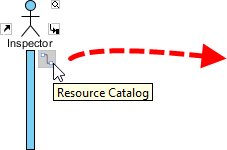
Using Resource Catalog - Release the mouse button at the place where you want the lifeline to be created.
- Select Message -> LifeLine from Resource Catalog.

To create a lifeline - A new lifeline will be created and connected to the actor/lifeline with a message. Enter its name and press Enter to confirm editing.

Lifeline created
Auto extending activation
When create message between lifelines/actors, activation will be automatically extended.
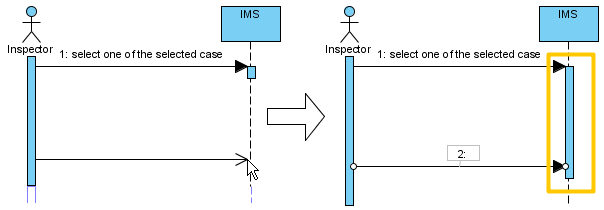 |
| Auto extending activation |
Using sweeper and magnet to manage sequence diagram
Sweeper helps you to move shapes aside to make room for new shapes or connectors. To use sweeper, click the Selector on the toolbar, then select Sweeper.
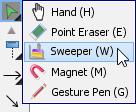 |
| sweeper |
Click on empty space of the diagram and drag towards top, right, bottom or left. Shapes affected will be swept to the direction you dragged.
The picture below shows the actorInspector Assistant is being swept towards right, thus new room is made for new lifelines.
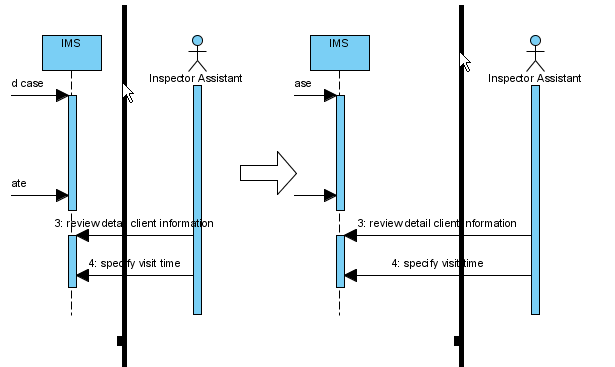 |
| Sweep towards right |
The picture below shows the message specify visit time is being swept downwards, thus new room is made for new messages.
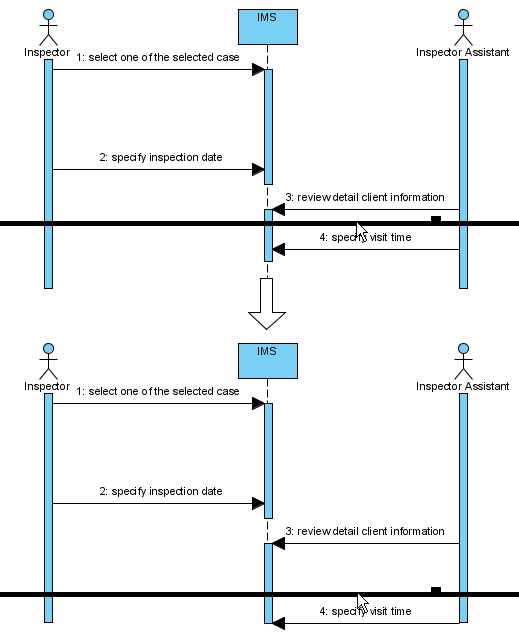 |
| Sweep downwards |
You can also use magnet to pull shapes together. To use magnet, click the Selector on the toolbar, then select Magnet.
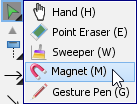 |
| Magnet |
Click on empty space of the diagram and drag towards top, right, bottom or left. Shapes affected will be pulled to the direction you dragged.
The picture below shows when drag the magnet upwards, shapes below dragged position are pulled upwards.
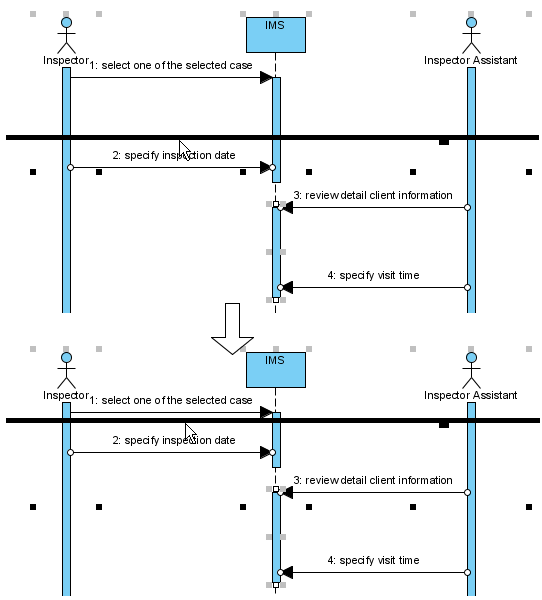 |
| Pull shapes upwards using magnet |
Creating combined fragment for messages
To create combined fragment to cover messages, select the messages, right-click on the selection and select Create Combined Fragment and then select a combined fragment type (e.g. loop) from the popup menu.
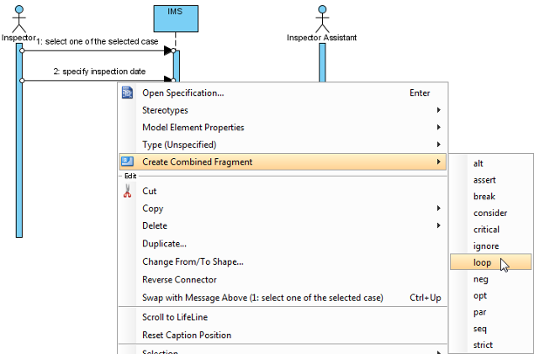 |
| Create combined fragment for messages |
A combined fragment of selected type will be created to cover the messages.
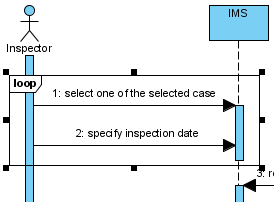 |
| Combined fragment created |
Adding/removing covered lifelines
After you've created a combined fragment on the messages, you can add or remove the covered lifelines.
- Move the mouse over the combined fragment and select Add/Remove Covered Lifeline... from the pop-up menu.
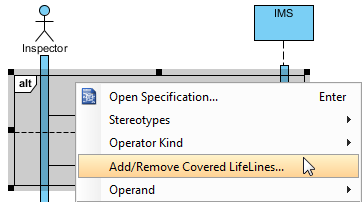
Add/Remove covered lifelines - In the Add/Remove Covered Lifelines window, check the lifeline(s) you want to cover or uncheck the lifeline(s) you don't want to cover. Click OK button.

Check Inspector Assistant
As a result, the area of covered lifelines is extended or narrowed down according to your selection.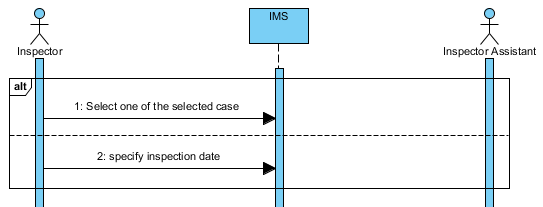
The area of covered lifelines is extended
Managing Operands
After you've created a combined fragment on the messages, you can also add or remove operand(s).
- Move the mouse over the combined fragment and select Operand > Manage Operands... from the pop-up menu.
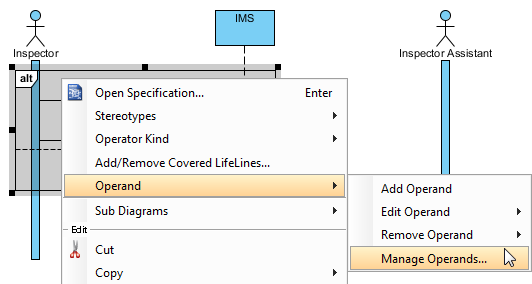
Manage operands - To remove an operand, select the target operand from Operands and click Remove button. Click OK button.
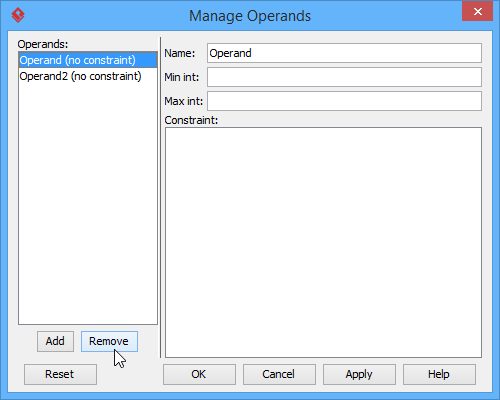
Remove Operand
Otherwise, click Add button to add a new operand and then name it. Click OK button.
Developing sequence diagram with quick editor or keyboard shortcuts
In sequence diagram, an editor appears at the bottom of diagram by default, which enables you to construct sequence diagram with the buttons there. The shortcut keys assigned to the buttons provide a way to construct diagram through keyboard. Besides constructing diagram, you can also access diagram elements listing in the editor.
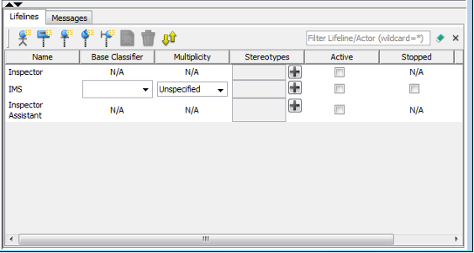 |
| The quick editor |
Editing lifelines
There are two panes, Lifelines and Messages. The Lifelines pane enables you to create different kinds of actors and lifelines.
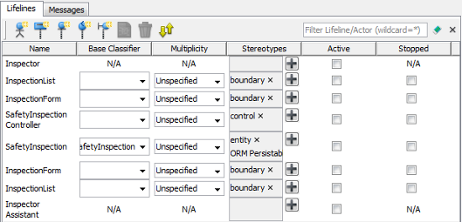 |
| Lifelines pane in quick editor |
Editing messages
The Messages pane enables you to connect lifelines with various kinds of messages.
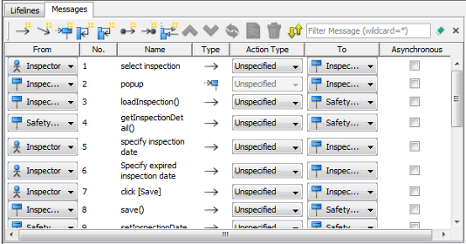 |
| Messages pane in quick editor |
Expanding and collapsing the editor
To hide the editor, click on the down arrow button that appears at the bar on top of the quick editor. To expand, click on the up arrow button.
 |
| Collapse the quick editor |
Setting different ways of numbering sequence messages
You are able to set the way of numbering sequence messages either on diagram base or frame base.
Diagram-based sequence message
Right click on the diagram's background, select Sequence Number and then either Single Level or Nested Level from the pop-up menu.
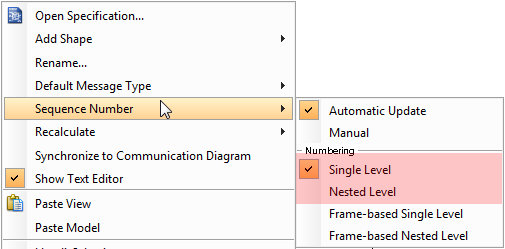 |
| Diagram-based pop-up menu |
If you choose Single Level, all sequence messages will be ordered with integers on diagram base. On the other hand, if you choose Nested Level, all sequence messages will be ordered with decimal place on diagram base.
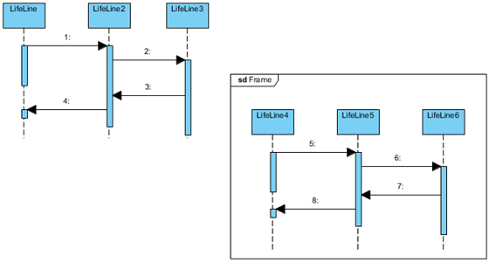 |
| Single level |
Frame-based sequence message
Right click on the diagram's background, select Sequence Number and then either Frame-based Single Level or Frame-based Nested Level from the pop-up menu.
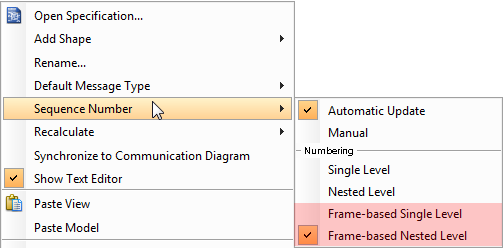 |
| Frame-based pop-up menu |
When you set the way of numbering sequence messages on frame base, the sequence messages in frame will restart numbering sequence message since they are independent and ignore the way of numbering sequence message outside the frame.
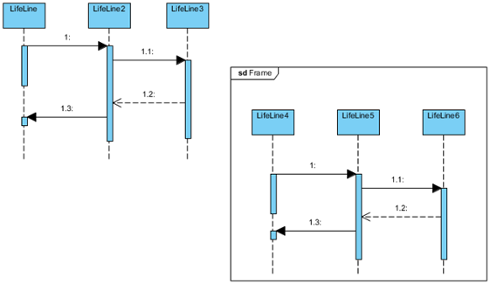 |
| Frame-based nested level |
Related Resources
The following resources may help you to learn more about the topic discussed in this page.
What’s New in the Code Visual to FlowChart 5.x serial key or number?
Screen Shot

System Requirements for Code Visual to FlowChart 5.x serial key or number
- First, download the Code Visual to FlowChart 5.x serial key or number
-
You can download its setup from given links:


